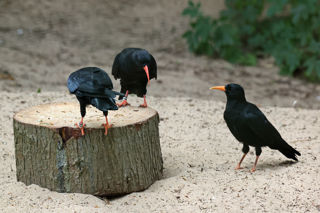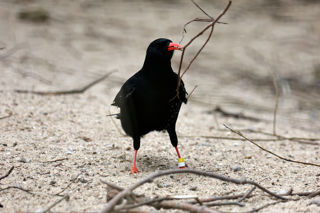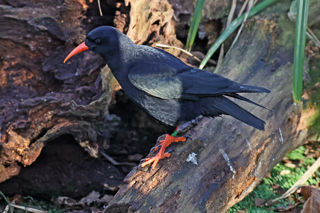
Red-Billed Chough
Pyrrhocorax pyrrhocorax
They are part of the crow family, it have black plumage. However, its bright red bill and legs sets it apart from all other corvids. Their bill is long and curved, adding insight to the feeding strategies of these birds.
Behaviour
Form monogamous lifelong bonds with their mates. Breeding pairs build nests in caves, rock faces and even buildings out of dry twigs, moss, grasses and animal fur.
Animal fur is used to line the inside of the nests, which is often rebuilt and re-lined when the nest is used in later years. Outside of the breeding season they roost communally. They also feed in pairs but within a larger flock of birds.
UK Status
Once widespread along the UK coastline, currently restricted along the west coast of Ireland, Wales and a small isolated population in Cornwall. The Cornwall choughs naturally recolonised in 2001, previous to this, they were extinct throughout England.
In 2010, a project by Durrell Wildlife Trust and The National Trust for Jersey, began restoring areas of grazing along the Jersey coastline with the hope of restoring a chough population on the island. A reintroduction of red-billed chough from 200 bred birds has now been successfully established with numerous pairs breeding in the wild.
Threats
Habitat loss due to the intensification of farming, as well as the complete abandonment of low intensity grazing means crucial feeding areas have become overgrown. Bad weather, predation and persecution can be considerable factors for smaller populations.

Distribution
A non-migratory bird found throughout southern Europe and in mountainous areas in Central Asia, India and China. Although the species has a broad distribution, populations are in decline. In the UK fewer that 450 pairs remain in small and isolated populations.
Habitat
Coastal areas with rocky crags and nearby short grassland pastures (preferably sheep grazed) are the key habitats for these birds. Form colonies and roost on rock crevices, ledges, cliff faces and abandoned buildings.
Diet
Mainly insectivorous, but eats a wide range of other invertebrates. Beetles, ants and fly larvae are important dietary items, with spiders, earthworms, berries and even cereal grains also being consumed.
Wildwood inside information
Before chough went extinct in the county, they had a strong association with Kent. As part of an ambitious project, Wildwood has teamed up with a number of partners including Kent Wildlife Trust to reintroduce this iconic species back to our Kent coastline. For more information, please visit our conservation page.
Family facts
Three choughs are depicted on the Canterbury City coat of arms and other civic regalia since the 14th century.



